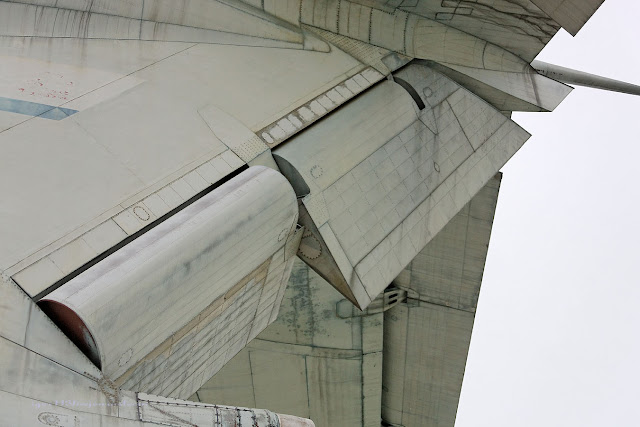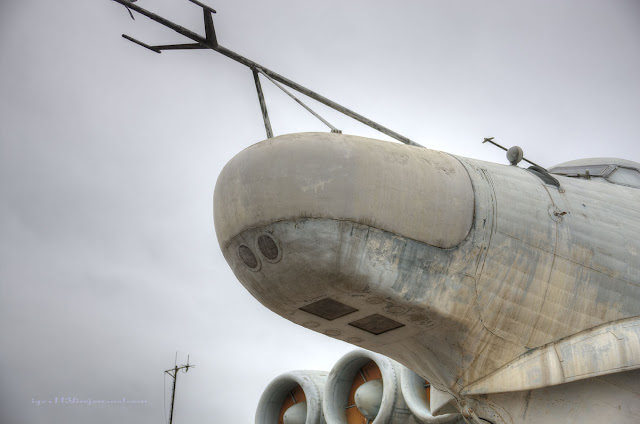A while back I found these images on English Russia (www.englishrussia.com) and I filed them away as potential weathering references. It is a ridiculous oversized, brutal and impractical Soviet jet seaplane, and surely that is reason enough to like this blog post. Aha, but I have more for you, dear reader! Let's talk about black basing and panel lines.


The ridiculous plane itself - KM Ekranoplan
This insane vehicle is the KM Ekranoplan, otherwise known as the "Caspian Sea Monster", which is as good a name as I ever saw for such a monstrosity. It was designed and tested in the mid-1960s. If you want to read more about it, check out its wikipedia page - there is also some old footage of it in flight:
I don't know about you, but I instantly like any aircraft where the closing line of its wikipedia entry states "The vehicle was too heavy to recover from its watery wreck site". Yay, Soviet Union!
So how does this relate to scale models?
I'm glad you asked. Originally, I saved these images as weathering references. This is a great example of an aircraft that hasn't moved since 1980, so almost forty years of sun and rain and snow have taken their toll.
But what really interests me is how this real item looks like a model that was black based.
For those who don't know, black basing is where a modeller paints a black base coat, and then successive random squiggles of lighter colour, before painting the final (fairly thin) coat of top paint. The idea is to give suitably random variation in the tone of the paint. For a full explanation of the technique, I can't do better than point you to this page on Doog's Models, another modelling blog.
 |
| The random blotchiness of black basing. Source: Doog's Models. Link. |
Lately I have seen some online discussion criticising pre-shading, black basing and the "Spanish School" of painting. Some modellers* believe that these painting styles are unrealistic, not true to scale, and the panel lines become too pronounced.
All I will say is: check out the pronounced panel lines on the Caspian Sea Monster. Check out the random blotchiness.
Anyway, all discussion about shaded panel lines aside, I love these photos. I love how utterly crazy this plane is, and I love how it looks now after almost forty years exposure.
Making models really does change the way you view the world.
Cheers,
Dave
_____________________________________________________________________________
* There will always be some modellers who bitch and moan about everything. You can't please everyone. Build what makes you happy, and say "up yours" to the minority who like to rivet count.
























There's a few versions of this monster in kit form.... I'm tempted.
ReplyDeleteIn unrelated, but sad news, your fellow countryman and master modeller Des Delatorre has died. As a (primarily) WWI modeller myself I know what an inspiration he was to thousands of us. And if I ever become a 1/144 scale as good as him, I'll be very happy.
HI Mike, I hadn't heard about Des Delatorre, he was a very talented modeller. Sad to learn of his death.
DeleteVery cool Dave. To your point, I think that aircraft would weather quite a bit differently depending on whether they are “in service” or derelict. That said, I think all techniques have a place....I just wish I was better at it.
ReplyDeleteOh, and my 2 cents (Euro) on pre-shading etc: I totally agree, build what you want, how you want it and damn the exact alignment of the fins on the torpedoes.
ReplyDeleteThat said, some panel-line shading has gotten pretty silly-looking, especially in the smaller scales. I see builds in the likes of SAMI with these totally exagerrated shades in 1/72 models that suggest to the eye that the panel lines are about six inches deep. But each to their own, I guess..
Agreed on small scale stuff the panel shading can look ridiculous. It is always a better technique (to my eyes at least) in 1/48 or larger scales. Some modellers can achieve it on 1/72 without it looking funky, but it's a lot trickier...
Delete